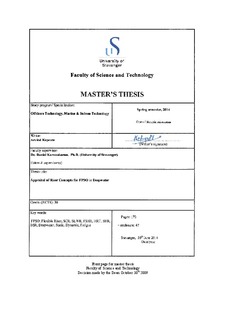| dc.contributor.author | Keprate, Arvind | |
| dc.date.accessioned | 2014-09-12T13:07:03Z | |
| dc.date.available | 2014-09-12T13:07:03Z | |
| dc.date.issued | 2014-06-30 | |
| dc.identifier.uri | http://hdl.handle.net/11250/219655 | |
| dc.description | Master's thesis in Offshore technology | nb_NO |
| dc.description.abstract | With oil and gas reserves moving into deeper waters Floating Production Units (FPUs) have been widely used for production purpose. Selection of FPU for deepwater field development is a complicated task is mainly governed by factors like water depth, location of field (remoteness), environmental conditions, deck space requirements, storage requirements and offloading requirements etc. Amongst all the available FPU alternatives ship shaped FPSO has undoubtedly dominated the concept selection and are generally used in marginal and remote fields lacking pipeline infrastructure.
Selecting riser concept for FPSO stationed in deepwater has posed challenges due high hydrostatic pressure and large vessel payload. The condition is worsened if besides deepwater, FPSO is also stationed in harsh environmental conditions. Under such conditions FPSO is subjected to large offsets and dynamics which are directly transferred along the riser length to its base unless riser is uncoupled from the FPSO.
One of the major factors governing the riser concept selection for deepwater FPSO is the geographical location and weather conditions prevalent there. For example free hanging flexible riser has been mostly used in moderate environments of offshore Brazil while concepts like Steel Catenary Riser (SCR) and Hybrid Riser Tower (HRT) are dominant in calm weather conditions of West of Africa (WoA).
Flexible risers in various configurations are currently the most widely used concept with turret moored FPSO in water depth up to 1500m. This can be accounted to their flexibility which allows them to accommodate large vessel offsets and also to be spooled on reels/carrousels for storage and installation purposes. But other factors like requirement of large diameter to increase collapse resistance, tendency to birdcage, large cost and increased weight limits its use beyond 2000m.
For past decade on of the alternatives to flexible riser for spread moored FPSO in deepwater benign environments has been SCR. SCR is not only a cheaper option but also permits use of large diameter sizes as required to withstand high hydrostatic pressure at larger depths. However SCRs are yet to find its application with deepwater FPSO in moderate to harsh environments due to their reduced fatigue life at hang-off and Touch Down Zone (TDZ). One way of improving the fatigue life of SCR is by changing the riser configuration from catenary to wave shaped (SLWR) by adding buoyancy to it and such a configuration is installed with turret moored FPSO (1780m) in offshore Brazil.
Two overcome the disadvantage of coupled riser systems like SCR, un-coupled riser concepts namely Hybrid Riser Tower (HRT), Single Hybrid Riser (SHR) and Buoyancy Supported Riser (BSR) have been installed. Fairly new un-coupled riser concepts like Grouped Single Line Offset Riser (SLOR), Catenary Offset Buoyant Riser Assembly (COBRA) and Tethered Catenary Riser (TCR) are being studied and developed for deepwater application.
Till date there is no FPSO stationed in water depths exceeding 1000m in Norwegian Continental Shelf (NCS). Case study is performed at the end of thesis with the aim of recommending suitable riser concept which can be hooked to internal turret moored FPSO stationed in 1500m water depth and harsh environmental conditions of Northern Norwegian Sea. Based on the literature review lazy wave configuration of flexible riser and Steel Lazy Wave Riser (SLWR) have been considered as a viable riser concept.
Main aim of this case study is to compare the two riser concepts on basis of vessel payload, fabrication cost and installation cost while the scope of study involves preforming static, dynamic and fatigue analysis of both the riser systems by using Orcaflex. At the end of thesis an effort has been made to come up with suitable conclusions and recommendations based on the work done in this thesis. | nb_NO |
| dc.language.iso | eng | nb_NO |
| dc.publisher | University of Stavanger, Norway | nb_NO |
| dc.relation.ispartofseries | Masteroppgave/UIS-TN-IKM/2014; | |
| dc.subject | offshore technology | nb_NO |
| dc.subject | offshore teknologi | nb_NO |
| dc.subject | undervannsteknologi | nb_NO |
| dc.subject | floating production units | nb_NO |
| dc.title | Appraisal of riser concepts for FPSO in Deepwater | nb_NO |
| dc.type | Master thesis | nb_NO |
| dc.subject.nsi | VDP::Technology: 500::Marine technology: 580::Offshore technology: 581 | nb_NO |
